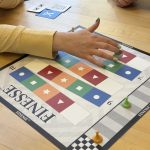Bluffing is a psychological gambit backed by mathematics — by mixing your play, masking your intentions, and forcing opponents into guessing games, you make them hesitate. The key is to know when to risk the bluff so that your deception becomes profitable rather than reckless
The Mathematics of Bluffing and When It’s Better to Risk it in Bridge, Poker & Beyond

The Mathematics of Bluffing and When It’s Better to Risk it in Bridge, Poker & Beyond
Imagine you are engaged in a heated game of poker. Your hand is not great, but you do not want to throw away your position. If only there were a strategy you could employ to make your opponents fold, allowing you to win this round. That’s when you decide to deceive them with subtle bets and raises, with the hope of forcing them to fold and thus winning you the pot. Congratulations, you have just bluffed.
Bluffing is a sophisticated strategy used in card games such as bridge and poker to deceive your opponents into believing you have a hand that is presumably better than theirs. Simply put, bluffing is a concealment strategy. A series of strategically placed bets and raises is used to conceal bad hands or draw players into playing with hands they might not have a chance of winning. However, it tends to work best when deployed at optimal moments.
A Calculated Risk in Poker
The mathematics of bluffing can help players decide when to take risks, when to fold, and how to leverage perception to their advantage. Poker is the most studied game when it comes to bluffing and is usually the first game people think of when they hear the term. Poker is all about numbers and probability. Understanding probability and deck distribution is critical in helping poker players read the game and their opponents.
The probability behind a good bluff starts with the value of your hand. Resources like a detailed poker hand rankings guide can be useful for any player learning how to bluff intelligently. Understanding the odds of each hand, coupled with knowing the edges that other players may hold can be a crucial factor in determining your strategy. Depending on the ways the cards have fallen, if you have an in-depth knowledge of how each poker hand works and how to leverage it can provide a slight edge.
Of course, knowing your opponents’ hands before they play them is impossible. Herein lies the risk. You only know your own cards, and they could be bluffing too, using their own concealment strategy to throw you off your game.
Why Bluffing Works
In strategic games where bluffing is a legitimate gameplay option, the act of bluffing combines probability and psychology. It is psychological warfare with mathematics as your armaments. Let’s look at some of the reasons bluffing is so effective and why so many players keep it in their arsenal:
Probability and body language
Most strategy game players rely on visible cues and perceived probabilities when deciding their strategies. They balance reading their opponents’ body language, looking for subtle clues that might give their play away, with analyzing the cards in play and the value of the pot. Here, knowing your opponents’ play styles and how to call their bluffs is an invaluable skill. Equally important is understanding how the game variables affect their strategies mid-game.
Game Theory
Game theory states that, in a non-cooperative game, players will always choose the optimal strategy in response to how their opponents are playing. This means that no player can improve their position in the game by unilaterally changing their own strategy, assuming their opponents’ strategies remain unchanged. From this, it can be deduced that bluffing must always exist at a certain frequency.
Mind games
The very nature of bluffing is calling your opponents out. This type of psychological interaction taps into opponents’ uncertainty, fear of loss, and risk aversion. The psychology of bluffing allows players to combine their understanding of mathematical probability in card distribution with social intelligence and the ability to read people.
Bluffing in Bridge
Bridge is more than just a card game. It combines wits, strategy, and psychology. There are many skills that bridge players are required to master, but bluffing stands out as one of the most intriguing and complex. Bluffing in bridge shares the same concepts as in poker. It is a deliberate attempt to deceive opponents about the strength of your hand. Where bridge differs from poker, however, is in its subtlety and nuance. It calls for a player to plant a false idea of their strategy or hand composition in the minds of their opponents through bids, leads, and plays. This forms part of a larger strategic framework in bridge that aims to:
- Disrupt opponents’ communication
- Create opportunities for your partner
- Apply pressure
- Provide psychological advantages
Bluffing is a powerful strategy that can not only give you an advantage but can also be a deciding factor in who wins the game. It is therefore important to know when and how to bluff effectively. If overused or executed poorly, an opponent might catch on to what you are doing and find a counter to your strategy. Understanding bluffing techniques is, therefore, just as important as knowing the rules of the game. Some key techniques for successful bluffing include:
1. False card play means using a card you wouldn’t ordinarily play to throw an opponent off from guessing your real hand.
2. A misleading lead is a similar tactic but this one means choosing to throw a different card initially to make your opponent believe your hand is weaker than it is.
3. Deliberately overbidding is a tactic that’s used in business as much as it is in play and involves peacocking to make your opponents bid higher than they may have at first.
4. Underbidding works the opposite way and can make opponents think your hand is weaker than it actually is.
5. Sacrificial bluffing entails a play that hurts you in the short term but serves a greater purpose for later.
Being strategic in bridge is paramount. Every play affects the game, either in a big or small way. Introducing bluffing into bridge brings a layer of excitement and unpredictability, transforming the game from a straightforward battle of logic into a psychological duel.
A word of caution. Some forms of ‘bluffing’ are illegal in sanctioned events. These include:
Deliberate changes in tempo – players must play in tempo and not hesitate or play super quickly in order to imply a certain card holding. This also applies to the bidding. Players must bid in tempo.
Lying in the bidding – this is often referred to as a ‘psychic’ bid. It can be done, and often is, but if a player does this too many times, it becomes close to a partnership agreement and will result in a penalty. Also, it is definitely not legal to lie about a conventional bid or call.
Partnership trust – keep in mind any bluffing you do will not just fool your opponents but your partner as well. This won’t always work out well. Bridge is, ultimately, a partnership game.
Cheating at bridge – there is always a fine line between bluffing and cheating at bridge. It’s important that you understand that line well.
Conclusion
While many card games are classified under gambling, there is more in play than just luck. Games such as bridge and poker are highly strategic games that require an understanding of probability, statistics, and opponent behavior. Beyond being able to play the hands you are dealt with, having a good grip on bluffing strategies and techniques will provide massive strategic advantages.
Knowing when to bluff and not to bluff is a skill valued by all seasoned players. Deciding to bluff hinges on ensuring the math is on your side; hence, it is crucial to understand hand compositions and rankings. Additionally, knowing your own behavior plays a big role in the success of your bluff. Other players will call your bluff based on your reputation and reliability, so developing the ability to hide your bluff and determining opponents’ tells are tools you should always have at the ready.








